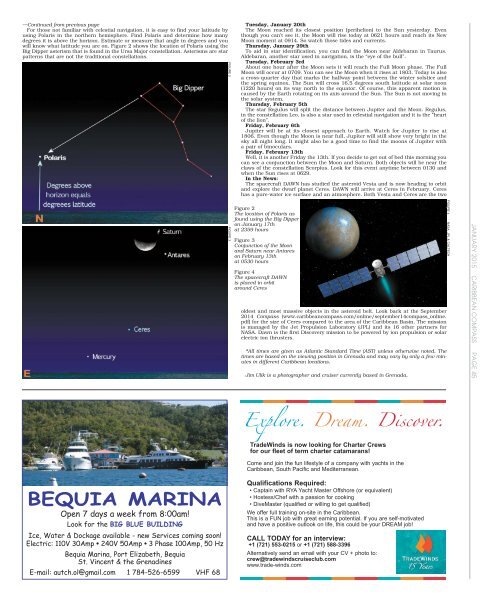Caribbean Compass Yachting Magazine January 2015
Welcome to Caribbean Compass, the most widely-read boating publication in the Caribbean! THE MOST NEWS YOU CAN USE - feature articles on cruising destinations, regattas, environment, events...
Welcome to Caribbean Compass, the most widely-read boating publication in the Caribbean! THE MOST NEWS YOU CAN USE - feature articles on cruising destinations, regattas, environment, events...
Create successful ePaper yourself
Turn your PDF publications into a flip-book with our unique Google optimized e-Paper software.
— Continued from previous page<br />
For those not familiar with celestial navigation, it is easy to find your latitude by<br />
using Polaris in the northern hemisphere. Find Polaris and determine how many<br />
degrees it is above the horizon. Estimate or measure that angle in degrees and you<br />
will know what latitude you are on. Figure 2 shows the location of Polaris using the<br />
Big Dipper asterism that is found in the Ursa Major constellation. Asterisms are star<br />
patterns that are not the traditional constellations.<br />
FIGURE 2 FIGURE 3<br />
Tuesday, <strong>January</strong> 20th<br />
The Moon reached its closest position (perihelion) to the Sun yesterday. Even<br />
though you can’t see it, the Moon will rise today at 0621 hours and reach its New<br />
Moon moment at 0914. So watch those tides and currents.<br />
Thursday, <strong>January</strong> 29th<br />
To aid in star identification, you can find the Moon near Aldebaran in Taurus.<br />
Aldebaran, another star used in navigation, is the “eye of the bull”.<br />
Tuesday, February 3rd<br />
About one hour after the Moon sets it will reach the Full Moon phase. The Full<br />
Moon will occur at 0709. You can see the Moon when it rises at 1803. Today is also<br />
a cross-quarter day that marks the halfway point between the winter solstice and<br />
the spring equinox. The Sun will cross 16.5 degrees south latitude at solar noon<br />
(1220 hours) on its way north to the equator. Of course, this apparent motion is<br />
caused by the Earth rotating on its axis around the Sun. The Sun is not moving in<br />
the solar system.<br />
Thursday, February 5th<br />
The star Regulus will split the distance between Jupiter and the Moon. Regulus,<br />
in the constellation Leo, is also a star used in celestial navigation and it is the “heart<br />
of the lion”.<br />
Friday, February 6th<br />
Jupiter will be at its closest approach to Earth. Watch for Jupiter to rise at<br />
1806. Even though the Moon is near full, Jupiter will still show very bright in the<br />
sky all night long. It might also be a good time to find the moons of Jupiter with<br />
a pair of binoculars.<br />
Friday, February 13th<br />
Well, it is another Friday the 13th. If you decide to get out of bed this morning you<br />
can see a conjunction between the Moon and Saturn. Both objects will be near the<br />
claws of the constellation Scorpius. Look for this event anytime between 0130 and<br />
when the Sun rises at 0629.<br />
In the News:<br />
The spacecraft DAWN has studied the asteroid Vesta and is now heading to orbit<br />
and explore the dwarf planet Ceres. DAWN will arrive at Ceres in February. Ceres<br />
has a pure-water ice surface and an atmosphere. Both Vesta and Ceres are the two<br />
Figure 2<br />
The location of Polaris as<br />
found using the Big Dipper<br />
on <strong>January</strong> 17th<br />
at 2359 hours<br />
Figure 3<br />
Conjunction of the Moon<br />
and Saturn near Antares<br />
on February 13th<br />
at 0530 hours<br />
Figure 4<br />
The spacecraft DAWN<br />
is placed in orbit<br />
around Ceres<br />
oldest and most massive objects in the asteroid belt. Look back at the September<br />
2014 <strong>Compass</strong> (www.caribbeancompass.com/online/september14compass_online.<br />
pdf) for the size of Ceres compared to the area of the <strong>Caribbean</strong> Basin. The mission<br />
is managed by the Jet Propulsion Laboratory (JPL) and its 16 other partners for<br />
NASA. Dawn is the first Discovery mission to be powered by ion propulsion or solar<br />
electric ion thrusters.<br />
*All times are given as Atlantic Standard Time (AST) unless otherwise noted. The<br />
times are based on the viewing position in Grenada and may vary by only a few minutes<br />
in different <strong>Caribbean</strong> locations.<br />
Jim Ulik is a photographer and cruiser currently based in Grenada.<br />
FIGURE 4 NASA, JPL & CALTECH<br />
JANUARY <strong>2015</strong> CARIBBEAN COMPASS PAGE 45<br />
Explore. Dream. Discover.<br />
BEQUIA MARINA<br />
Open 7 days a week from 8:00am!<br />
Look for the BIG BLUE BUILDING<br />
Ice, Water & Dockage available - new Services coming soon!<br />
Electric: 110V 30Amp • 240V 50Amp • 3 Phase 100Amp, 50 Hz<br />
Bequia Marina, Port Elizabeth, Bequia<br />
St. Vincent & the Grenadines<br />
E-mail: autch.ol@gmail.com 1 784-526-6599 VHF 68<br />
TradeWinds is now looking for Charter Crews<br />
for our fleet of term charter catamarans!<br />
Come and join the fun lifestyle of a company with yachts in the<br />
<strong>Caribbean</strong>, South Pacific and Mediterranean.<br />
Qualifications Required:<br />
• Captain with RYA Yacht Master Offshore (or equivalent)<br />
• Hostess/Chef with a passion for cooking<br />
• DiveMaster (qualified or willing to get qualified)<br />
We offer full training on-site in the <strong>Caribbean</strong>.<br />
This is a FUN job with great earning potential. If you are self-motivated<br />
and have a positive outlook on life, this could be your DREAM job!<br />
CALL TODAY for an interview:<br />
+1 (721) 553-0215 or +1 (721) 588-3396<br />
Alternatively send an email with your CV + photo to:<br />
crew@tradewindscruiseclub.com<br />
www.trade-winds.com


















